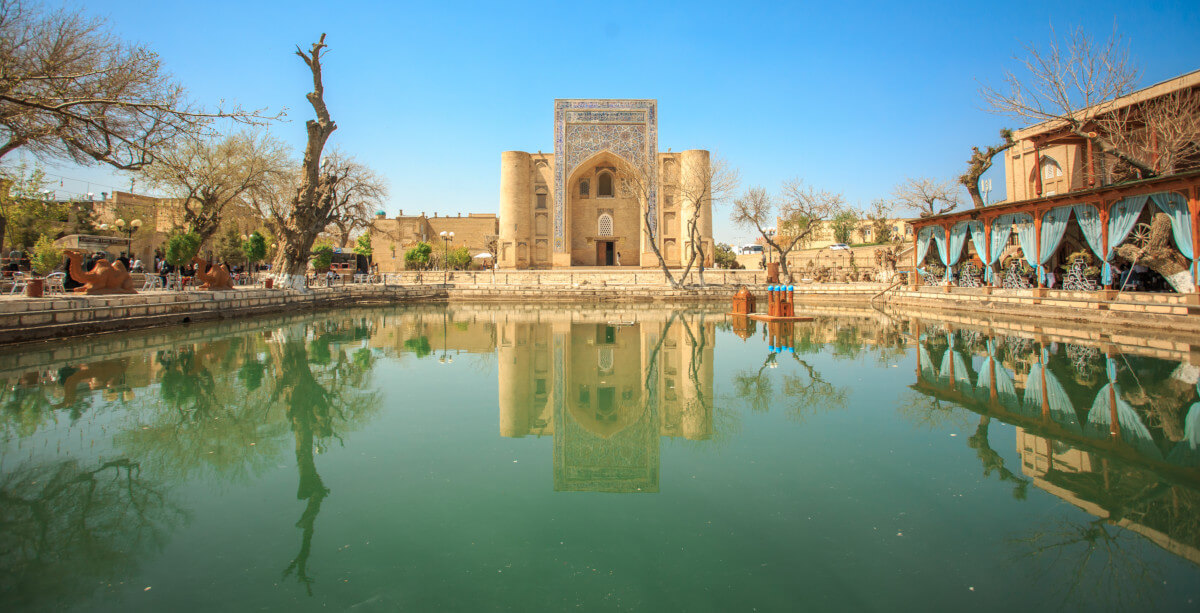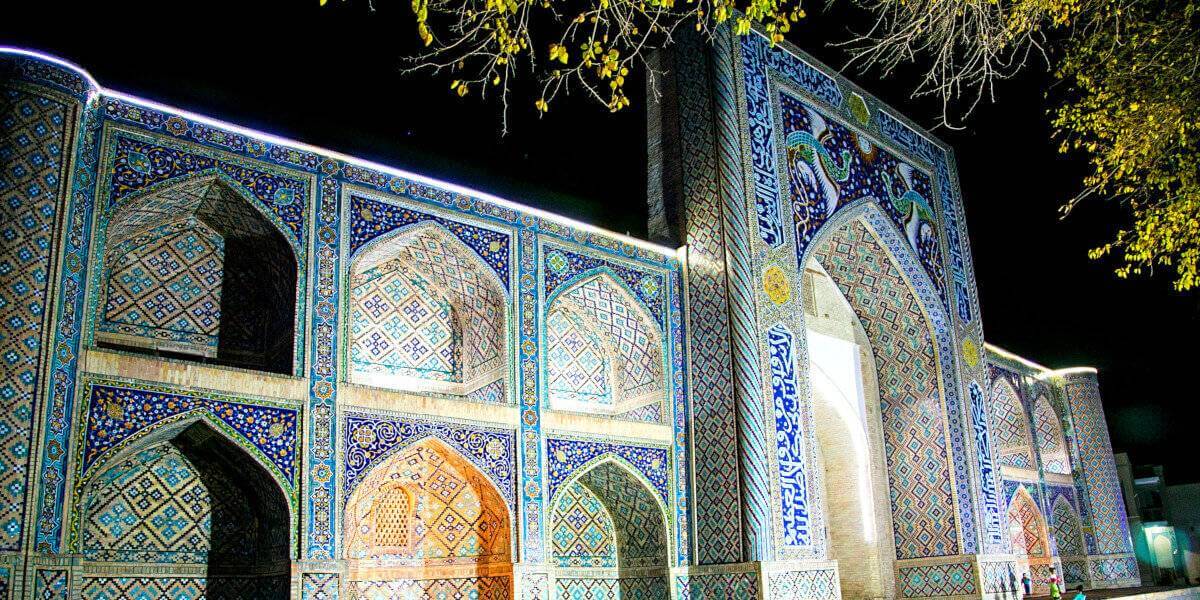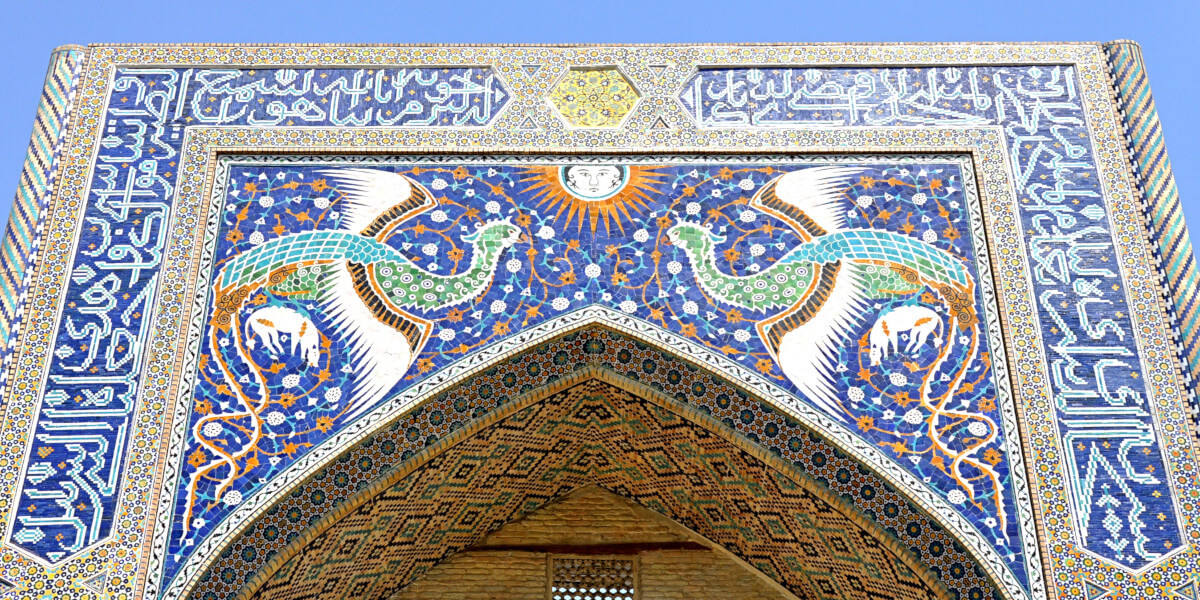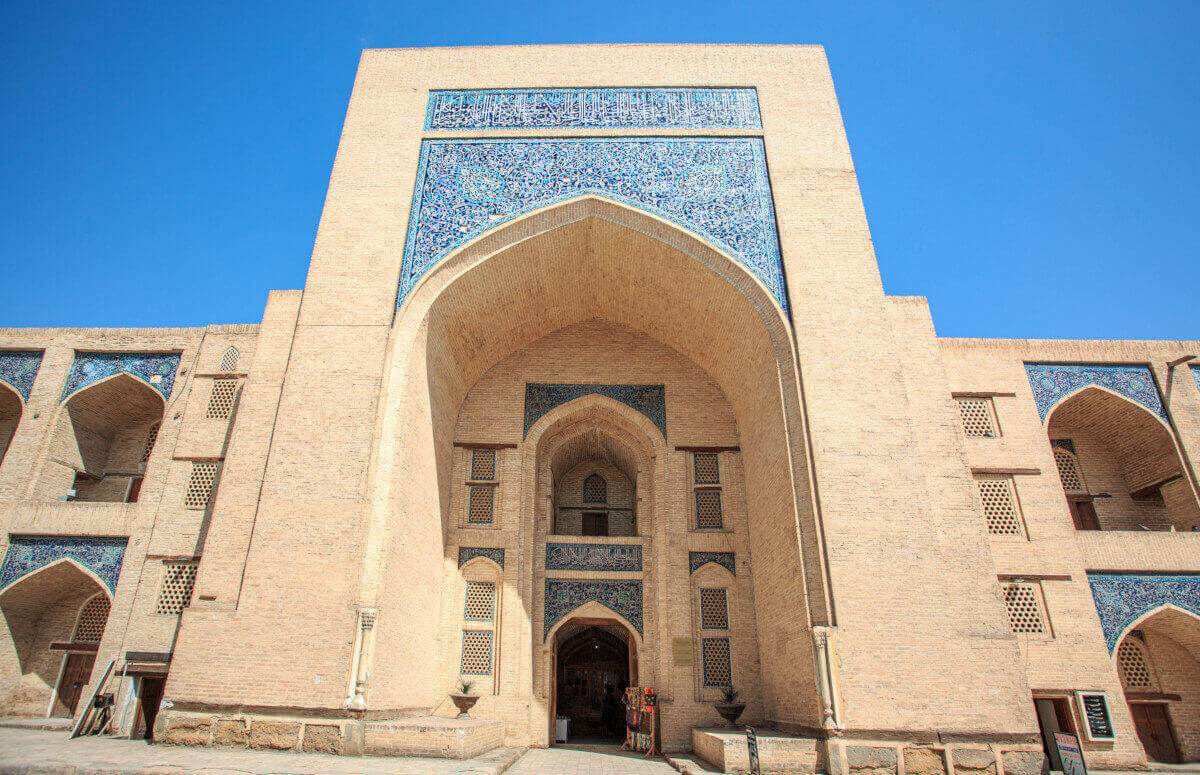The ensemble’s heart is the water basin (“khauz”), providing refreshment in the hot summer months. The khauz is framed in the west by the Nadir Divan-begi Khanaka (dervish lodge), in the east by the Nadir Divan-begi Madrasah, both named after the ensemble’s founder. To the north is the Kukeldash Madrasah. You will not miss a restaurant with Uzbek cuisine right by the water basin. A number of other restaurants, hotels and souvenir shops are located in the immediate vicinity.
Nadir Divan-begi Khanaka
Khanaka is a convent for pilgrims who could find shelter here. Initially, they were very modest, but over time they developed into entire complexes, which usually housed a mosque and sometimes a mausoleum. Later, khanakas became centres of knowledge, where reading, writing and religion were taught. Often libraries were also located in the khanaka.
They were usually funded by donations from rulers or rich people, as it was considered a charitable deed.

The building’s construction was initiated by Nadir Dīvan-begi in 1620, finance minister and uncle of the ruler Imamkuli Khan, and was named after him. The building is part of the Lyabi-Khauz ensemble and is situated opposite Nadir Divan-begi Madrasah. The khanaka was built close to the pool, and its façade is reflected in water in fine weather.
The building is rectangular with an area of 25 by 35 metres. A dome above the main hall is hidden behind the entrance portal and is only visible from the side. The entrance portal bears the usual style and is flanked by two round towers that give the building a compact look. The hall inside the building was used for prayers, meetings and meditations.
The Nadir Divan-begi khanaka was rebuilt in 1914-1916 by order of the last Emir of Bukhara.
Nadir Divan-begi Madrasah
Nadir Divan-begi Madrasah was initially built as a caravanserai (a large inn enclosing a courtyard providing accommodation for caravans) and later rebuilt as a madrasah. Legend has it that construction was about to finish when the khan (king) passed close by the street praising the “beautiful madrasah”. Since the khan was never wrong, the building was immediately turned into a madrasah.

The Nadir Divan-begi started the construction in 1623, finance minister and uncle of Imamkuli Khan. Thus, the madrasah and the khanaka of Nadir Divan-begi were built on the principle of Kosh (two buildings facing each other). However, due to the relatively large distance between the two buildings and the fact that there are a pond and a small park between them, visually, it is barely noticeable.
The madrasah has a square base with an edge length of about 70 metres. Two floors of student rooms surround the inner courtyard. Due to the original plan of using the building as a caravanserai, large classrooms are absent here. The madrasah was probably only used to house students. At best, the larger rooms in the corners were used for teaching purposes.
Especially beautifully decorated is the building’s façade, which is adorned with mosaics and majolica. The animal depiction is unusual: it shows two large Semurg birds from Persian mythology, which resembles the phoenix bird known in the west. This is a distinguishing feature, as representations of living creatures on Islamic buildings were generally not permitted.

The madrasah was renovated in the 1960-1970s. Today the courtyard is home to a craft centre where a variety of arts and crafts are produced by artisans by hand using century-old techniques and approaches. Every evening Nadir Divan-begi Madrasah hosts a folk show in its courtyard, highlighting Uzbek dances accompanied by traditional instruments.
Kukeldash Madrasah
Kukeldash Madrasah was built in 1569 by the order of Kulbab Kukeldash. “Kukeldash” is a title that means “milk brother”. Kulbab Kukeldash was the milk brother of ruler Abdullah Khan II and served the khan as vizier and commander. The madrasah is the oldest building of the Lyabi-Khauz Ensemble.
The building is rectangular, with an area of 69 by 80 metres. It is the largest madrasah in Bukhara and one of the largest in Central Asia. Compared to its size, which was supposed to symbolize the power of Bukhara, the decoration is relatively modest.

One hundred sixty rooms can accommodate a total of 320 students. There are two large dome-covered rooms on either side of the entrance: one was used as a classroom, while the other was used as a mosque. It is worth noticing the openwork window lattices above the doors of every single room, called a “panjara”. Each “panjara” was individually decorated and showed options of creating a pattern based on a hexagon.
The famous Soviet writer Sadriddin Aini once lived in Kukeldash Madrasah, where he wrote his book “Bukhara” in two volumes. He described in detail the process and method of teaching in the madrasah.
During the Soviet period, the madrasah was used as a hotel. A large room to the left of the main entrance was used as a cinema. Between 1995 and 1997, the madrasah was restored. Today there are several souvenir shops inside the building.